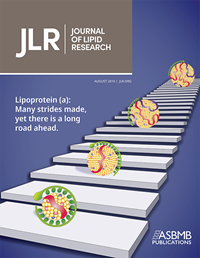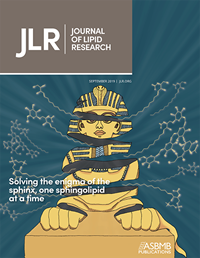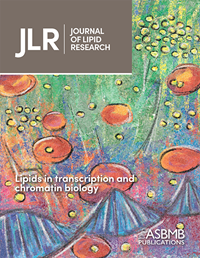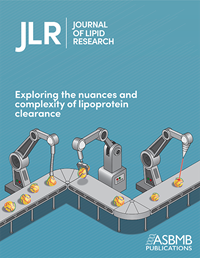JLR junior associate editors organize virtual issues
The junior associate editors of the Journal of Lipid Research have organized four virtual issues highlighting cutting-edge research published by the journal.

Lipoprotein (a): Many strides made, yet there is a long road ahead
In this virtual issue, the JLR highlights early-career researchers pushing our understanding of lipoprotein (a) pathophysiology forward. According to Gissette Reyes-Soffer of the Columbia University Irving Medical Center, a better grasp of lipoprotein (a) is necessary to improve risk evaluations and targeted therapies for cardiovascular disease and diabetes.
The cover art depicts the Lp(a) particle following the steps of a walking path, increasing in size as the road goes into infinity. Read the collection.

Solving the enigma of the sphinx, one sphingolipid at a time
Recent studies have advanced our understanding of sphingolipids and their biologic roles in health and disease. This virtual issue, organized by Rotonya Carr of the University of Pennsylvania Perelman School of Medicine, also highlights both established and new investigators in the field who undoubtedly are the future of sphingolipid research.
The cover art features the structures of several sphingolipids being freed as the Sphinx unravels. Read the collection.
Exploring the nuances and complexity of lipoprotein clearance
This virtual issue, assembled by Brandon Davies of the University of Iowa Carver College of Medicine, highlights studies that advance our understanding of lipoprotein clearance and illustrate the breadth and diversity of lipoprotein-clearance research.
The cover art depicts different mechanisms acting to clear and modify lipoproteins on an assembly line representing the circulation. Read the collection.

Lipids in transcription and chromatin biology
Ray Blind of the Vanderbilt University School of Medicine put together a virtual issue showcasing recent papers showing that lipids actively participate in epigenetic reprogramming, chromatin modifications and nucleosome structure, along with their more well-established roles in splicing, RNA export and transcriptional regulation.
The cover art is an abstract representation of nuclear lipids participating in the regulation of transcription and chromatin biology. Read the collection.
Enjoy reading ASBMB Today?
Become a member to receive the print edition four times a year and the digital edition monthly.
Learn moreGet the latest from ASBMB Today
Enter your email address, and we’ll send you a weekly email with recent articles, interviews and more.
Latest in Science
Science highlights or most popular articles

Building the blueprint to block HIV
Wesley Sundquist will present his work on the HIV capsid and revolutionary drug, Lenacapavir, at the ASBMB Annual Meeting, March 7–10, in Maryland.

Gut microbes hijack cancer pathway in high-fat diets
Researchers at the Feinstein Institutes for Medical Research found that a high-fat diet increases ammonia-producing bacteria in the gut microbiome of mice, which in turn disrupts TGF-β signaling and promotes colorectal cancer.

Mapping fentanyl’s cellular footprint
Using a new imaging method, researchers at State University of New York at Buffalo traced fentanyl’s effects inside brain immune cells, revealing how the drug alters lipid droplets, pointing to new paths for addiction diagnostics.

Designing life’s building blocks with AI
Tanja Kortemme, a professor at the University of California, San Francisco, will discuss her research using computational biology to engineer proteins at the 2026 ASBMB Annual Meeting.

Cholesterol as a novel biomarker for Fragile X syndrome
Researchers in Quebec identified lower levels of a brain cholesterol metabolite, 24-hydroxycholesterol, in patients with fragile X syndrome, a finding that could provide a simple blood-based biomarker for understanding and managing the condition.

How lipid metabolism shapes sperm development
Researchers at Hokkaido University identify the enzyme behind a key lipid in sperm development. The findings reveal how seminolipids shape sperm formation and may inform future diagnostics and treatments for male infertility.

